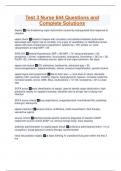Test 3 Nurse 644 Questions and
Complete Solutions
Sepsis ✅Life-threatening organ dysfunction caused by dysregulated host response to
infection
septic shock ✅Subset of sepsis with circulatory and cellular/metabolic dysfunction
associated with higher risk of mortality. It is a type of vasodilatory or distributive shock.
sepsis with fluid unresponsive hypotension. systolic bp <100, lactate >2, need
vasopressors to keep MAP > 65
SIRS S/S ✅Arterial Hypotension SBP < 90 MAP < 70, tachycardia/pulse > 90,
tachypnea > 20/min, hypertension, leucocytosis, leukopenia, fever/temp > 38.3 or < 36,
Pac02 <32, unknown infectious source, signs of end organ perfusion, lab signs
sepsis risk factors ✅ICU admission, bacteremia, advanced age > 65,
immunosuppression, diabetes/obesity, cancer, precious hospitalization, genetic factors
sepsis signs and symptoms/2 ✅Warm flush skin—> cool when in shock, decrease
capillary refill, cyanosis, mottling, oliguria, hyperglycemia, hypoxic, increase creatinine,
increase lactate, anuria, AMS, illeus, leukocytosis > 10-12k, leukopenia < 4K is a bad
sign
SOFA score ✅early identification of sepsis. used to identify organ dysfunction; high-
predictive validity for inpatient mortality; identifies who is at high-risk of dying from
infection
SOFA score criteria ✅lung respirations; coagulation/plts; liver/bilirubin/lfts; cardio/bp;
brain/gcs; kidney/rfts
sepsis treatment ✅source control, antibiotics, initial resuscitation, fluid therapy,
vasoactive agents
source control ✅identify/exclude specific anatomic diagnosis of infection ASAP.
implement source control ASAP; ex; remove foreign body, drain abscess
antibiotic administration for sepsis/septic shock ✅antibiotics administered within 1 hr of
recognition, broad spectrum empiric therapy recommended
initial resuscitation sepsis ✅at least 30ml/kg IV crystalliod fluid given within the first 3
hrs
, methods to check intravascular volume ✅NICOM 10-15% patient needs more volume,
CVP 8-12, check IVC diameter, passive leg raise
When the pt. requires substantial amounts of crystalliods ✅albumin, avoid
hyperchloremic acidosis from fluid
sepsis bp goals ✅target MAP 65 mmHg, nore is the 1st line choice vasopressor, add
epi/vasopressin up to 0.03 to maintain MAP goal, or to decrease nore dose
if shock not resolving ✅further assess cardiac function, check heart with ultrasound,
check labs, UO, steroids
sepsis summary recommendations ✅start resuscitation early with source control, IV
fluids and antibiotics, frequent assessment of volume status, guide resuscitation to
normalize lactate as a marker of tissue hypoperfusion
sepsis documentation ✅clinical manifestations of infection and organ dysfunction,
possible source, source control, resuscitation, focused exam, measurement of
intravascular volume status, fluid responsiveness
Compartment Syndrome ✅condition in which increased pressure within one of the
body's anatomical compartments results in insufficient blood supply to tissue within that
space
Diagnosing compartment syndrome ✅1.based on history, exam finding and
measurement of compartment pressures. 2.compartment pressure isn't required to
obtain compartment syndrome. 3. five P's. 4.direct pressure. 5.delta pressure (diastolic
blood pressure - compartmental pressure)
Causes of compartment syndrome ✅trauma to extremity, often in males <35, fractures,
thermal injuries, limb compression, exercise
Compartment Syndrome Treatment ✅neurovascular checks, compartment checks,
early surgical intervention, fasciotomy. (weak, thready pulses, does it feel softer or
,more firm, cap refill).
Rhabdomyolysis ✅muscle necrosis leading to the release of intracellular muscle
components into the circulation. CK and Myoglobin. untreated compartment syndrome
may lead to rhabdo.
Signs and symptoms of rhabdomyolosis ✅muscle pain, red/brown urine, elevated CK
and myoglobin, CK >1500 up to 100,000, muscle stiffness, cramping, malaise, fever,
n/v, elevated HR, keep an eye out for DIC




